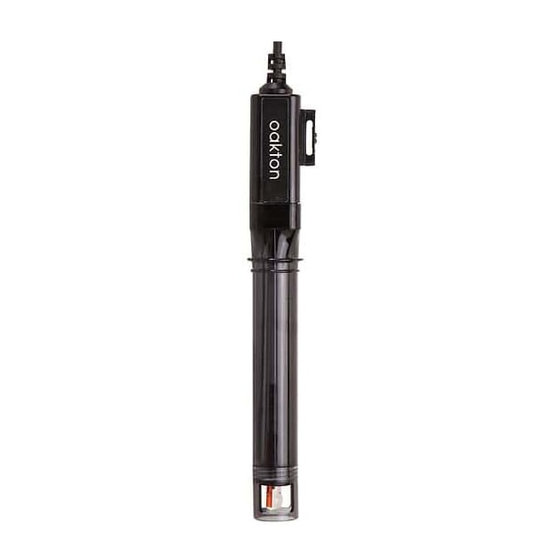
Table of Contents
Advertisement
Quick Links
Gel-filled pH Electrode (35660-54 / 35660-56)
This manual describes the operation of the gel-filled pH
electrode, 35660-54/35660-56. Be sure to read this manual
carefully, before using the electrode.
Conformable standards
This equipment conforms to the following standards:
RoHS: EN50581
9. Monitoring and control instruments
Authorised representative in EU
Cole-Parmer UK
9 Orion Court, Ambuscade Road
Colmworth Business Park
St Neots
Cambridgeshire
PE19 8YX, United Kingdom
Phone: +44-(0)1480-272279
Fax: +44-(0)1480-212111
Caution on use
Safety precautions
CAUTION
Chemical solution
If the internal material comes in contact with the hands or skin,
wash immediately with water.
Glass fragments
Glass fragments can cause injury.
The tip of the electrode are made of glass.
Be careful not to break them.
Points of concern
Do not give an excessive shock to the electrode.
Cracked or chapped electrode can not be used.Replace
such electrode with a new one.
Do not wet the connector with water or sample and do
not touch the connector with wet fingers. If it is wet
measured value might be erroneous.
If the dirt on the responsive glass membrane or liquid
junction can not be removed by pure water, clean them
with the other way referring to the Maintenance.(Refer to
" Maintenance " (page 2).)
Avoid continuous measurement soaking in the strong
acidic or alkaline solution concentrated more than 0.01
mol/L. These solution may reduce the performance and
the lifetime of the electrode.
Do not to use the electrode in a solution in which
hydrofluoric acid (HF) is contained. Glassware will
corrode in the HF solution.
Avoid sudden temperature change over 50 °C on the
electrode. The body of the electrode might be deformed
or the glassware might be cracked.
Solid particles of silver chloride might be observed
floating in the inner solution of the responsive glass
membrane. This is not a problem and this will not affect
performances of the electrode.
Do not use the electrode in any place where operation
temperature is out of the specified range.
Do not swing the electrode like a pendulum, and do not
pull up the electrode by the lead wire. Also, avoid
Oakton Instruments
625 E. Bunker Ct. Vernon Hills, IL. 60061, USA
E-mail: info@4oakton.com
Phone number: (1)888-462-5866
Instruction Manual
When disposing of the product, follow the related laws
Packaged contents
Specifications and parts description
Part name
Responsive glass
membrane
Guard tube
Electrode connector
Temperature connector
Specifications
Electrode model
Measurement range
Operation temperature range
Storage temperature range
Internal electrode
Reference electrode system
Reference electrode internal
electrolyte
Liquid junction material
Wetted material
Electrode length
Ext. diam. of wetted part
Liquid junction height
Cable length
Connector
Temperature probe
Maximum dipping depth
Zero point
Body material is plastic. Do not use organic solvents (such as
acetone or toluene).
For any questions regarding this product, please contact your local agency,
or inquire from the following website.
http://www.4oakton.com/
CODE:M003857-3200839729-GZ0000590175
hanging the electrode or the pH meter by the lead wire.
It may be a cause of breaking wires.
and/or regulations of your country for disposal of the
product.
Name
Electrode
1 pc
Instruction manual (this book) 1 booklet
Protective cap
Cap
Liquid junction
Body
Connector cover
35660-54, 35660-56
pH 0 to 14
0°C to 80°C
0°C to 50°C
Silver/silver chloride
Double junction
Polymer-gel, 3.3 mol/L KCl
Porous sintered polyethylene
Glass, butyl rubber, polycarbonate,
polyethylene
150 mm
16 mm
Approximately 15 mm
(from the tip of electrode)
10D: 1 m 20D: 2 m
BNC/Mini plug
NTC
1 m
pH7.0
Note
December, 2019
Q'ty
Lead
Advertisement
Table of Contents

Subscribe to Our Youtube Channel
Summary of Contents for Oakton PH200
- Page 1 Do not swing the electrode like a pendulum, and do not pull up the electrode by the lead wire. Also, avoid Oakton Instruments For any questions regarding this product, please contact your local agency, or inquire from the following website....
- Page 2 Preparations 5. Shake the electrode in the sample solution lightly to remove bubbles. If bubbles remain on the electrode Connecting to pH meter surface, accurate measurement cannot be performed. 1. Insert the electrode connector into the connector port sleeve on the meter, after aligning with the pin.
- Page 3 Storage 1. Clean the electrode well with pure water (or deionized water) to remove sample completely and wipe it with filter paper or tissue paper. 2. Add enough pure water (or deionized water) to soak the sponge in the protective cap, and then discard the residual water.















Need help?
Do you have a question about the PH200 and is the answer not in the manual?
Questions and answers